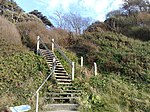The Needles

The Needles are a row of three stacks of chalk that rise about 30 metres (98 ft) out of the sea off the western extremity of the Isle of Wight in the English Channel, United Kingdom, close to Alum Bay and Scratchell's Bay, and part of Totland, the westernmost civil parish of the Isle of Wight. The Needles Lighthouse stands at the outer, western end of the formation. Built in 1859, it has been automated since 1994. The waters and adjoining seabed form part of the Needles Marine Conservation Zone and the Needles along with the shore and heath above are part of the Headon Warren and West High Down Site of Special Scientific Interest. The formation takes its name from a fourth needle-shaped pillar called Lot's wife, which collapsed in a storm in 1764. The remaining rocks are not at all needle-like, but the name has stuck. The Needles were featured on the BBC Two TV programme Seven Natural Wonders (2005) as one of the wonders of Southern England. During Storm Eunice on 18 February 2022, the highest recorded wind gust in England was provisionally recorded at The Needles, at 122 miles per hour (196 km/h). LB&SCR H2 class 4-4-2 no. 423 (later no. B423 and 2423) was named The Needles after this landmark.
Excerpt from the Wikipedia article The Needles (License: CC BY-SA 3.0, Authors, Images).The Needles
T25,
Geographical coordinates (GPS) Address Nearby Places Show on map
Geographical coordinates (GPS)
| Latitude | Longitude |
|---|---|
| N 50.6626968 ° | E -1.5893269 ° |
Address
The Needles Lighthouse
T25
PO39 0JD
England, United Kingdom
Open on Google Maps










